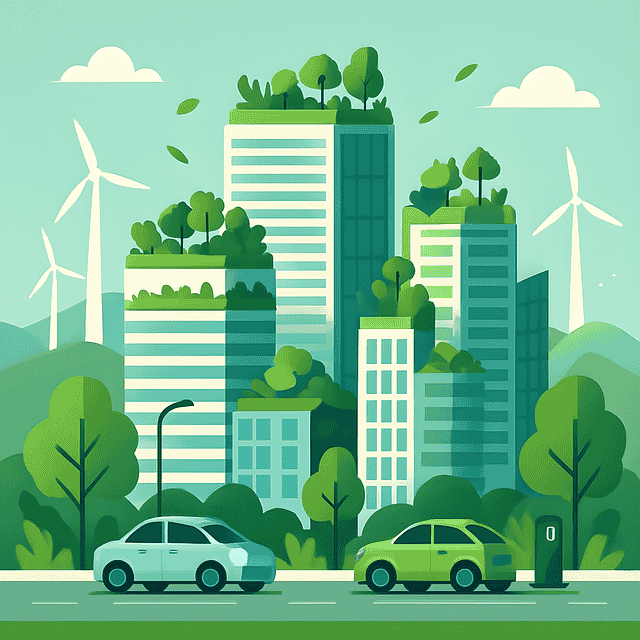Over the last few years, the technology sector has emerged as one of the most influential drivers of global sustainability. What was formerly considered primarily a source of invention and profitable growth, the industry is now playing center stage in responding to pressing environmental challenges, from reducing emissions to optimizing resource use. In this composition, we cover five crucial ways that the tech industry is shaping a green future, comprising energy efficiency, instrument support, greener transportation, smarter manufacturing, and circular economy practices.
Making Transportation Greener
Although the transportation sector represents a large share of global emissions, the tech sector is rapidly changing this paradigm. Electric buses are not only conducive to new battery technologies that lessen reliance on fossil fuels and lower greenhouse gases, but tech companies are also investing in autonomous technologies that curb routing inefficiencies, minimize time spent idling, and enhance energy efficiencies. Digital logistics programs are changing the dynamic of freight via optimizing delivery routes and loads themselves. Public transportation systems utilized data analytics and IoT applications to establish more efficient transit, reduce road congestion, and promote sustainable commuting solutions. These inventions inclusively add to cleaner cities, reduced noise pollution, and a sustainable transportation ecosystem.
Streamlining Manufacturing Processes
Manufacturing has long been a resource-intensive sector, but technology is reconsidering product effectiveness through robotization and precision analytics. Digital twins—virtual representations of physical systems—empower manufacturers to simulate workflows, detect inefficiencies, and anticipate equipment breakdowns prior to happening. AI-based robotics optimizes material consumption and enables the comparison of that usage, utilizing minimal waste generation. Additionally, additive manufacturing (3D printing) supports just-in-time production, which eliminates excess inventories and reduces the carbon costs for shipping. IoT sensors constantly monitor equipment performance, providing real-time feedback on energy performance and machine health.
Simplifying the Path to Certification
Sustainability certifications like B Corp, LEED, and ISO 14001 have become the sure signs of good business standards. But getting the certifications can be very difficult because of the challenges in cost and compliance. Here, technology comes in as a hero to help meet the certification standards with the help of easy data collection, automated reporting, and also, transparency in supply chain management. Cloud technology aids environmental metrics while AI verifies the credibility of documented evidence and compliance. Many organizations also invest in reliable B Corp consulting services to align sustainability goals with measurable standards. By integrating digital tools with expert guidance, businesses can accelerate certification timelines, reduce administrative burdens, and demonstrate their commitment to ethical and environmental excellence.
Driving Energy Efficiency Through Smart Technologies
The tech sector has been very instrumental in turning the sustainability perspective globally upside down. One of its waterfront technologies can be named among the smart technologies, savvy energy consumption, and resource waste that not only decrease the sum of money paid for energizing the whole building but also reduce the carbon emissions of the building in a very eco-friendly way. Smart grids, smart building systems, and an energy management tool powered by AI are the things that electricity is obtained, moved around, and delivered through in a different way. Companies and cities, therefore, can reduce carbon emissions while maintaining output. These inventions not only conserve energy but also foster a culture of conscious consumption, a profound signal of an abecedarian shift toward sustainable structure.
Enhancing Circular Economy Practices
The transition from linear to circular depends a great deal on technological invention. Tech-driven recycling systems employ machine learning for better sorting and valorization of waste. Blockchain makes the material exercise and resale more transparent and ensures responsibility throughout a product’s life. Cloud-based resource management systems enable companies to track, partake, and redistribute surplus assets across networks, reducing waste while maximizing value. Electronics companies are designing modular products that are easy to repair or upgrade, therefore extending life and reducing e-waste. Bedding the circularity into digital systems helps the tech industry stimulate sustainable consumption and resource regeneration on a global scale.
In conclusion, where technology meets sustainability, it’s no longer an abstract proposition but a functional reality driving industries and communities across the globe. From energy effectiveness to greener transportation, streamlined instruments, and beyond, the tech sector is establishing fabrics that integrate profitability with environmental stewardship. As invention presses forward in this respect, its contribution toward the attainment of global climate objectives grows increasingly critical. By applying data, robotization, and smart design, the tech industry isn’t only lessening its footprint but also moving other sectors to do the same.

